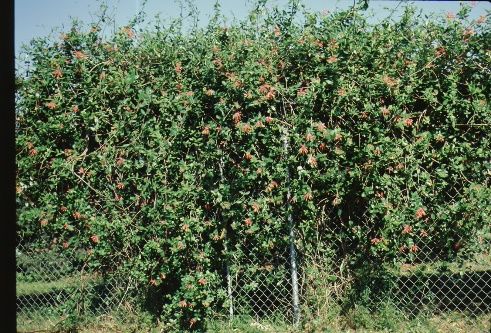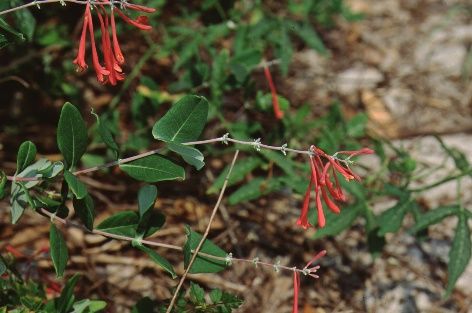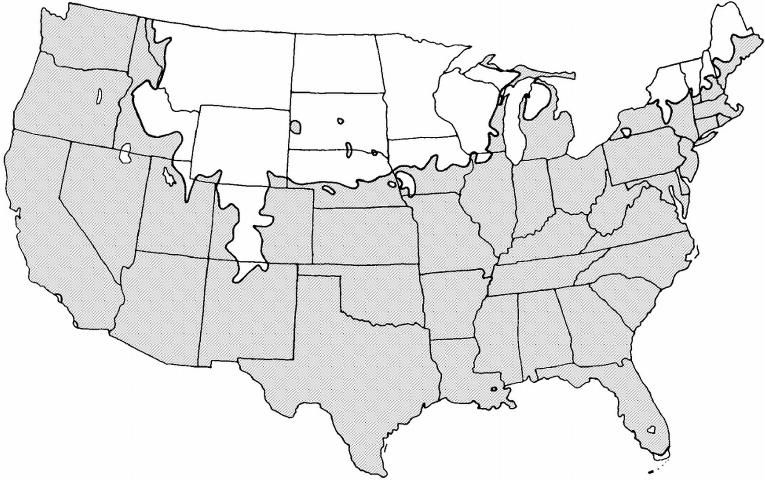Introduction
Although a vigorous twining vine, the native trumpet honeysuckle does not spread out of control quite as easily as Japanese honeysuckle. The delicate but striking, two-inch-long, tapered, trumpet-shaped crimson blooms appear from April through summer and are set against a background of dark green, smooth leaves. The flowers are particularly attractive to hummingbirds but are not fragrant. Evergreen in the lower South, trumpet honeysuckle may die back during a hard freeze. Quickly covering fences, lampposts, or mailboxes, trumpet honeysuckle is an excellent vine to use for naturalizing. Train it onto an arbor or trellis in the full sun for good, thick coverage.

Credit: Edward F. Gilman, UF/IFAS

Credit: Edward F. Gilman, UF/IFAS
General Information
Scientific name: Lonicera sempervirens
Pronunciation: lah-NISS-ser-ruh sem-per-VYE-renz
Common name(s): coral honeysuckle, trumpet honeysuckle
Family: Caprifoliaceae
Plant type: vine
USDA hardiness zones: 4 through 10A (Figure 3)
Planting month for zone 7: year round
Planting month for zone 8: year round
Planting month for zone 9: year round
Planting month for zone 10: year round
Origin: native to Florida
Invasive potential: aggressive, spreading plant
Uses: hanging basket; attracts hummingbirds
Availability: generally available in many areas within its hardiness range

Credit:
Description
Height: depends upon supporting structure
Spread: depends upon supporting structure
Plant habit: spreading
Plant density: moderate
Growth rate: fast
Texture: medium
Foliage
Leaf arrangement: opposite/subopposite
Leaf type: simple
Leaf margin: entire
Leaf shape: ovate
Leaf venation: pinnate
Leaf type and persistence: semi-evergreen
Leaf blade length: less than 2 inches
Leaf color: green
Fall color: no fall color change
Fall characteristic: not showy
Flower
Flower color: red
Flower characteristic: spring flowering; summer flowering
Fruit
Fruit shape: round
Fruit length: less than 0.5 inch
Fruit cover: unknown
Fruit characteristic: inconspicuous and not showy
Trunk and Branches
Trunk/bark/branches: typically multi-trunked or clumping stems
Current year stem/twig color: reddish
Current year stem/twig thickness: thin
Culture
Light requirement: plant grows in part shade/part sun
Soil tolerances: slightly alkaline; clay; sand; acidic; loam
Drought tolerance: moderate
Soil salt tolerances: unknown
Plant spacing: 36 to 60 inches
Other
Roots: not applicable
Winter interest: no special winter interest
Outstanding plant: plant has outstanding ornamental features and could be planted more
Pest resistance: no serious pests are normally seen on the plant
Use and Management
Trumpet honeysuckle tolerates most soils except dry sands. As with many vines, some training may be needed to direct growth. Vines will accumulate foliage on top of a fence or other structure but yearly heading back can encourage growth close to the ground. It is best suited for sunny locations and flowers poorly in the shade.
Propagation is by softwood cuttings that root easily or layering stem sections where they touch the ground.
Several cultivars are available: 'Sulphurea' has bright yellow flowers; 'Superba' has bright scarlet flowers and broadly oval leaves; and 'Magnifica' has large, bright red blooms and is late-flowering.
Pests and Diseases
No pests are of major concern.
Aphids suck plant juices and coat the leaves with sticky honeydew. The insects can be dislodged with high pressure water sprays from the garden hose. Leaf rollers roll leaves together, then web them in place. Hand pick infested leaves. Four-lined plant bug causes sunken, round, brown spots on the leaves. The injury is sometimes mistaken for a disease. Adult insects are yellowish green with black stripes.
No diseases are of major concern.
Many fungi cause leaf spots, but chemical control is rarely warranted.
Various genera of powdery mildews form white powder on the leaves.